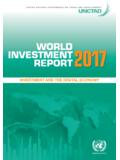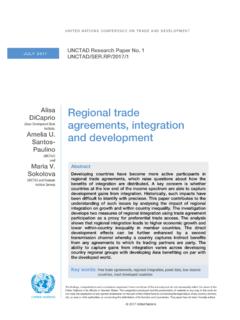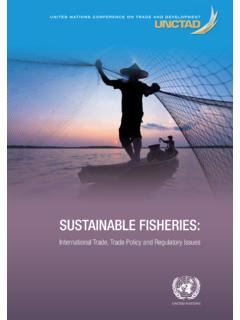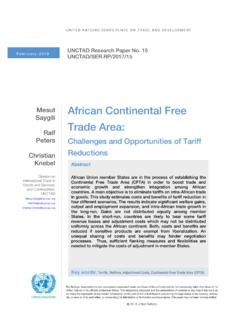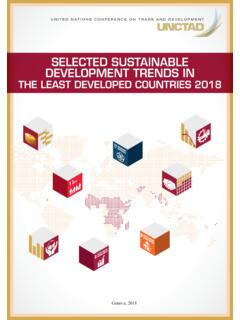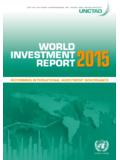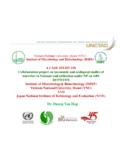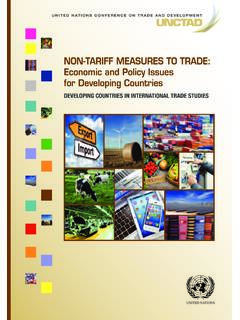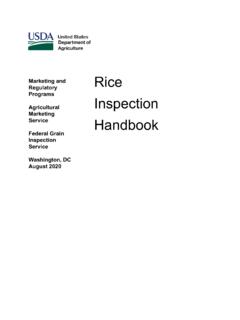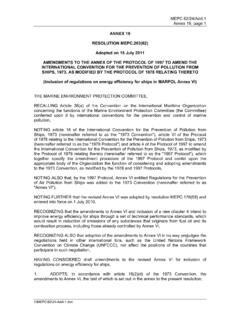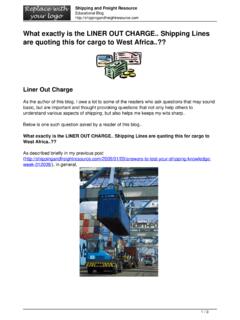Transcription of Review of Maritime Transport 2021 - Overview
1 U N I T E D N AT I O N S C O N F E R E N C E O N T R A D E A N D D E V E L O P M E N T. EMBARGO. The contents of this report must not be quoted or summarized in the print, broadcast, electronic or social media before 18 November 2021, 0600 GMT. Review . OF Maritime . Transport . 2021. Overview . U N I T E D N AT I O N S C O N F E R E N C E O N T R A D E A N D D E V E L O P M E N T. Review . OF Maritime . Transport . 2021. Overview . Geneva, 2021. 2021, United Nations This work is available through open access, by complying with the Creative Commons licence created for intergovernmental organizations, at The designations employed and the presentation of material on any map in this work do not imply the expression of any opinion whatsoever on the part of the United Nations concerning the legal status of any country, territory, city or area or of its authorities, or concerning the delimitation of its frontiers or boundaries.
2 Mention of any firm or licensed process does not imply the endorsement of the United Nations. Photocopies and reproductions of excerpts are allowed with proper credits. This publication has been edited externally. United Nations publication issued by the United Nations Conference on Trade and Development. UNCTAD/RMT/2021 ( Overview ) and 2. Review OF Maritime Transport 2021. Overview . Overview . Maritime Transport defied the COVID-19 disruption. In 2020, volumes fell less dramatically than expected and by the end of the year had rebounded, laying the foundations for a transformation in global supply chains and new Maritime trade patterns The COVID-19 pandemic disrupted Maritime Transport , though the outcome was less damaging than initially feared. The shock in the first half of 2020 caused Maritime trade to contract by per cent in the year 2020. But in the second half of the year there was a nascent, if asymmetric, recovery, and by the third quarter, volumes had returned, for both containerized trade and dry bulk commodities.
3 However, there has yet to be a full recovery for tanker shipping. Maritime trade has performed better than expected partly because the COVID-19 pandemic unfolded in phases and at different speeds, with diverging paths across regions and markets. The rebound in trade flows was also the result of large stimulus packages, and increased consumer spending on goods, with a growth in e-commerce, especially in the United States. Later, there was more general optimism in advanced regions from the rollout of vaccines. But it was also partly due to unlocking pent-up demand for cars, for example, and to restocking and inventory-building. The rebound was fairly swift because, unlike the global financial crisis of 2009, the downturn was not synchronized across the world. In 2021, in tandem with the recovery in merchandise trade and world output, Maritime trade is projected to increase by per cent (figure 1). The medium-term outlook also remains positive, though subject to mounting risks and uncertainties, and moderated in line with projected lower growth in the world economy.
4 Over the past two decades, compound annual growth in Maritime trade has been per cent, but over the period 2022 2026, UNCTAD expects that rate to slow to per cent. 3. Review OF Maritime Transport 2021. Overview . Figure 1 International Maritime trade and world gross domestic product (GDP) and Maritime trade-to-GDP ratio, 2006 to 2021. (percentage annual change and ratio). 9. 8. 7. Average ratio 2006-2014 Average ratio 2015-2021. 6. 5. 4. 3. 2. 1. 0 2006 2007 2008 2009 2010 2011 2012 2013 2014 2015 2016 2017 2018 2019 2020 2021. -1. -2. -3. -4. -5. -6. GDP Maritime trade Maritime trade-to-GDP ratio Average ratio Source: UNCTAD calculations, based on the Review of Maritime Transport , various issues, data from UNCTAD stat and table of the UNCTAD Trade and Development Report 2021. From recovery to resilience: The development dimension. Maritime Transport navigated through the pandemic, but there was an unprecedented humanitarian crisis for seafarers While carriers generally managed to mitigate the shock and disruption, port and landside operations found it more difficult to adjust, and seafarers were in a precarious situation as the pandemic triggered an unprecedented global crew-change crisis.
5 The health risks and related travel restrictions meant that hundreds of thousands of seafarers could not return home, while an equivalent number were unable to join their ships and to provide for their families. 4. Review OF Maritime Transport 2021. Overview . Hardest hit has been tanker shipping, but the impact has been less for containerized trade, gas shipments, and dry bulk commodities Lockdowns, travel restrictions and production cuts have compressed the demand for fuel. In 2020, shipments of crude oil, refined petroleum products, and gas together fell by per cent. The impact was less, however, for dry bulk commodity trade: supported by strong demand from China for iron ore and grain, total dry bulk trade fell by only per cent. Containerized trade also resisted, falling by only per cent. Global container port throughput fell at a similar rate . and in 2020 totalled million twenty-foot equivalent units (TEU).
6 Logistical bottlenecks, and soaring costs, along with an asymmetric recovery, have heightened uncertainty Maritime trade weathered the storm in 2020 and the short-term outlook remains positive. However, the emerging multi-paced recovery is inherently fragile as many countries and regions continue to lag. In addition to new pandemic risks and the dangers of a two-track vaccination pattern where developing countries continue to fall behind, other risks are casting a shadow on the recovery. While not all countries have been able to deploy large stimuli packages and support measures, an untimely ending of the existing support measures in advanced economies could potentially stifle growth and hinder the nascent recovery. The pandemic's impacts and legacies are likely to linger and the future shape and contours of the next normal for the world economy remain uncertain. The nascent recovery has also been hindered by supply-chain bottlenecks.
7 The rebound in trade, combined with pandemic-induced restrictions in logistics operations has led to shortages in equipment and containers, along with less reliable services, congested ports and longer delays and dwell times. For shipping, on the other hand, soaring freight rates, surcharges and fees have bolstered profitability. Freight rates increased further following the March 2021 closure of the Suez Canal. The grounding of the 20,150-TEU container ship Ever Given blocked the canal, delaying ships heading for Europe, and increasing the constraints on ship and port capacity. Some voyages had to be re-routed around the Cape, adding up to 7,000 miles to the distance. 5. Review OF Maritime Transport 2021. Overview . Whether the recovery lasts will depend critically on the path of the pandemic. Fresh waves of infection, combined with low vaccination rates, especially in developing countries, have led to new lockdowns and border closures.
8 A broad-based recovery hinges to a large extent on a worldwide vaccine rollout. The International Monetary Fund estimates that $50 billion are required to end the pandemic and roll out vaccines across developing countries. This would bring not just health but also economic benefits since it would be tantamount to a large scale economic stimulus package that could accelerate economic recovery and by 2025 generate some $9 trillion in additional global output. Seafarers are increasingly being recognized as key workers who are keeping shipping and trade moving, while also being at the front line of the health crisis. Since seafarers come predominantly from developing regions, industry and government should move quickly to implement vaccine procurement and distribution plans. The longer-term outlook is being reshaped by structural megatrends that transcend the pandemic and its immediate impact Eventually, the logistical hurdles caused by large swings in demand could dissipate as global trade patterns normalize.
9 However, the pandemic has also accelerated megatrends that in the longer-term could transform the Maritime Transport landscape. By exposing the vulnerabilities of existing supply chains, the COVID-19. disruption has sharpened the need to build resilience. COVID-19. emphasized the importance of ensuring continuity in supply chains and the need for them to become more resilient, responsive, and agile. Discussions over the future of globalization have ushered calls to take a fresher look at the configuration of the extended supply chains to reduce heavy reliance on distant suppliers. Some are arguing that reshoring and nearshoring will accelerate, resulting in deep reconfiguration of supply chains. While the structural trends that had emerged over a decade ago and accelerated during recent trade tensions are likely to result in changes to globalization patterns and features, an outright end to globalization per se is unlikely.
10 It may be fairly straightforward to reshore labour-intensive and low- value production, but it is more complex to move production and 6. Review OF Maritime Transport 2021. Overview . switch suppliers for mid-and high-value-added manufacturing. Instead, enterprises are likely to blend local and global sourcing, modifying their strategies according to product and geography with a blend of reshoring, diversification, replication, and regionalization. Nevertheless, for the near future China is likely to remain a leading manufacturing site. Automation could make reshoring and nearshoring more economically viable in the longer term. Hybrid operating models involving just-in-time ( , material moved just before its use in the manufacturing process) and just-in-case ( , where companies keep large inventories to minimize stocks being sold out) supply chain models are likely to emerge. Combined, these trends will change distances and routes, increasing the need for more flexible shipping services.
